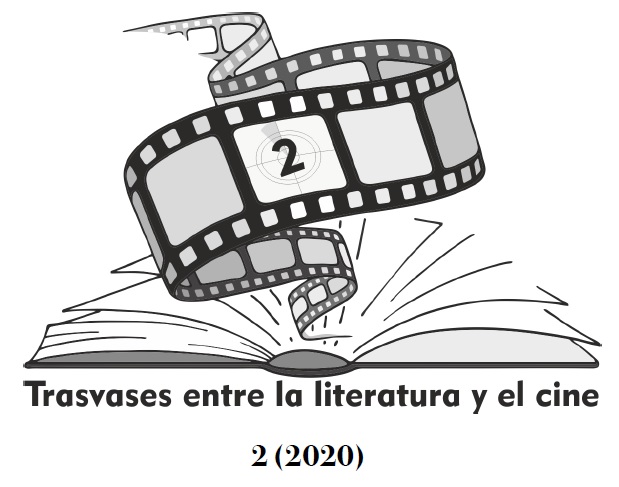A fantastic macabre fable. Macario (Roberto Gavaldón, 1960) from "The Third Guest" (1950) by Bruno Traven
DOI:
https://doi.org/10.24310/Trasvasestlc.vi2.9013Keywords:
Macario, Roberto Gavaldón, Bruno Traven, Gabriel Figueroa, death, story, cinema, MexicoAbstract
This work makes a comparative analysis between the story "The Third Guest" (1950) by B. Traven and its film adaptation “Macario” (1959) directed by Roberto Gavaldón. The article contextualizes the German author's short novel with respect to the story of the Grimms, the author's enigmatic figure, his particular relationship with the world of cinema and the different cinematographic adaptations of his literary work. A study about the production of the film and the transfer of the story to the screen has been made, in which both coincidental and divergent approaches has been used to analyse the adaptation of the text. Finally, this adaptation has been related to the thematic and iconographic references as well as the connections and influences on which the film is made.
Downloads
Metrics
Publication Facts
Reviewer profiles N/A
Author statements
Indexed in
-
—
- Academic society
- N/A
- Publisher
- Universidad de Málaga
References
ARRIAGA BENÍTEZ, Juan Manuel (2019), «La construcción del significado en el cine: un análisis sobre Macario (1960)», Diseminaciones, 2/4, págs. 143-155 [En línea: http://diseminaciones.uaq.mx/index.php/ojs/article/view/55/34. Fecha de consulta: 30/04/2020]. ASTORGA RIESTRA, Paula (2019), «Roberto Gavaldón. Un devenir cinematográfico», en Q. Casas (ed.), Roberto Gavaldón, San Sebastián/Madrid, Festival de San Sebastián/Filmoteca Española, págs. 11-20.
BELINCHÓN, Gregorio (2019), «Roberto Gavaldón, la leyenda del cineasta olvidado», El País, 15.412 [En línea: https://elpais.com/cultura/2019/09/24/actualidad/1569312360_651163.html. Fecha de consulta: 29/04/2020].
BERGAN, Ronald (2001), Serguéi Eisenstein, Una vida en conflicto, Barcelona, Alba. CROWTHER, Bosley (1961), «The Screen: ‘Macario’: Folk Tale-Fantasy of Mexico in Premiere», The New York Times, 28 de septiembre de 1961 [En línea: https://www.nytimes.com/1961/09/28/archives/the-screen-macariofolk-talefantasy-of-mexico-in-premiere.html. Fecha de consulta: 05/04/2020].
EISENSTEIN, Serguéi M. (1988), Yo, memorias inmorales, México, Siglo XXI.
FIGUEROA, Gabriel (2005), Memorias, México, Equilibrista/UNAM.
FIGUEROA, Gabriel (2008), «Recordando a B. Traven», Luna Córnea, 32, págs. 509-530.
GRIMM, Jacob y Wilhelm (2016), «La muerte madrina», Textos.info [En línea: https://www.textos.info/hermanos-grimm/la-muerte-madrina. Fecha de consulta: 30/04/2020].
HAUSCHILD, Jan-Christoph (2012), «El hombre que se inventó a si mismo: Otto Feige y sus seudónimos Red Marut y B. Traven (1882-1969)». Anuari de filología. Literatures Contemporànies, 2, págs. 53-68 [En línea: https://revistes.ub.edu/index.php/AFLC/article/view/5487. Fecha de consulta: 22/04/2020].
HUSTON, John (1998), Memorias, Madrid, Espasa.
ISAAC, Alberto (1993), Conversaciones con Gabriel Figueroa, Guadalajara, Universidad de Guadalajara.
LEYVA, José M. y Mariana RIVA (2007), El cine en México y el mundo. Cronología de Gabriel Figueroa, México, Fundación Televisa.
MARTÍNEZ ASSAD, Carlos (2015), «El cine de Revueltas», Revista de la Universidad de México, 132, págs. 60-65 [En línea: http://www.revistadelauniversidad.unam.mx/ojs_rum/index.php/rum/article/view/16525/0. Fecha de consulta: 04/05/2020].
MEMBREZ, Nancy (2007), «El peón y la muerte. El caso transnacional de Macario (1960)», Latinoamericana, 44, págs. 27-58 [En línea: http://www.scielo.org.mx/pdf/latinoam/n44/2448-6914-latinoam-44-27.pdf. Fecha de consulta: 02/05/2020].
MINO GRACIA, Fernando (2007), La fatalidad urbana. El cine de Roberto Gavaldón, México, UNAM.
MONSIVÁIS, Carlos (1994), Gabriel Figueroa. La mirada en el centro, México, Porrúa.
MONSIVÁIS, Carlos (2006), Imágenes de la tradición viva, México, UNAM.
MUNGUÍA, Jorge e Isis SAAVEDRA (2010), «Enigmas de Bruno Traven», Revista de la Universidad de México, 76, págs. 84-94 [En línea: http://www.revistadelauniversidad.unam.mx/ojs_rum/index.php/rum/article/view/1778/2781. Fecha de consulta: 22/04/2020].
OROZCO, Héctor (2019), «Con los ojos de una cámara. Roberto Gavaldón y los fotógrafos de cine», en Q. Casas (ed.), Roberto Gavaldón, San Sebastián/Madrid, Festival de San Sebastián/Filmoteca Española, págs. 151-164.
PAZ, Octavio (1997), El laberinto de la soledad y otras obras, Nueva York, Penguin.
PEÑA MARTÍNEZ, Francisco (2014), Por un análisis antropológico del cine. Imaginarios fílmicos, cultura y subjetividad, México, Navarra.
PÉREZ VÁZQUEZ, Reynol y Ana PELLICER (2006), Pina Pellicer, luz de tristeza (1934-1964), México, UNAM.
SAVORIT, Antonio (2007), Gabriel Figueroa, México, Fundación Televisa.
TRAVEN, Bruno (2009), La nave de los muertos, Barcelona, Acantilado.
TRAVEN, Bruno (2019), Macario. Un cuento del México colonial, México, Libros de México (edición Kindle).
TRAVEN, Bruno (2019), Canasta de cuentos mexicanos. México, Libros de México (edición Kindle).
TRAVEN, Bruno (2020), El secreto de la Sierra Madre, México, Libros de México (edición Kindle).
VÁZQUEZ MANTECÓN, Álvaro (1996), «Los tres grandes eran cuatro», en E. Levín et. al. (eds.), Gabriel Figueroa y la pintura mexicana, México, Museo Carrillo Gil, págs. 29-38.
VEGA ALFARO, Eduardo de la (2019), «Notas sobre la dupla artística Roberto Gavaldón-Ignacio López Tarso», en Q. Casas (ed.), Roberto Gavaldón, San Sebastián/Madrid, Festival de San Sebastián/Filmoteca Española, págs. 129-138.
VILA-MATAS, Enrique (2002), Bartleby & compañía, Barcelona, Anagrama.
WILSON, Sheilah R. (1975), «The Fantasy of Bruno Traven: Macario», Latin American Literary Review, 6, págs. 17-21 [En línea: https://www.jstor.org/stable/20118957?seq=1. Fecha de consulta: 07/05/2020].
Downloads
Published
How to Cite
Issue
Section
License
All authors published in this journal accept the following copyright terms:
a. Authors retain their authors´ rights (copyright) and grant First Publication Rights to the journal, which whill be published under a the Creative Commons Attribution-NonCommercial-ShareAlike 4.0 International (CC BY-NC-SA 4.0) license. All about this license is available in the following link: <http://creativecommons.org/licenses/by-nc-sa/4.0>
b. Authors may separately establish additional agreements for the non-exclusive distribution of the version of the work published in the journal (e.g. including it in an institutional repository, or publishing it in a book) with an acknowledgement of its initial publication in this journal.
c. Authors are allowed and encouraged to disseminate their work electronically (e.g. in institutional repositories or on their own website) as this can lead to productive exchanges, as well as earlier and more extensive citation of published work.
The author is responsible for obtaining permission from the copyright holder when using copyrighted materials.
This electronic journal is published by University of Málaga (UmaEditorial), thus it is necessary to cite the origin of any partial or total reproduction.








22.png)










